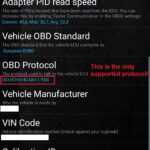The OBD2 port on a 1999-2005 Mazda Miata can be a source of frustration for owners seeking to access engine data. This article clarifies its location, functionality, and common issues.
Where to Find the Miata OBD2 Port
The OBD2 port in a 1999-2005 Miata is located beneath the steering wheel, to the left of the steering column and above the clutch pedal. It’s a female, trapezoidal-shaped connector, often recessed and partially obscured by the dashboard trim.
Functionality of the 1999-2005 Miata OBD2 Port
While the 1999-2005 Miata has an OBD2 port, its functionality is limited compared to later models. It primarily supports basic OBD2 protocols for emissions-related diagnostics and provides access to limited live data, such as:
- Engine Coolant Temperature (ECT): Generally considered reliable and usable for data logging and monitoring.
- Engine RPM: Often reported as being too slow and erratic for accurate data acquisition.
- Throttle Position (TPS): Similar to RPM, the data refresh rate is often too slow to be useful.
- Vehicle Speed: Functionality can vary; in some Miatas, it may not be connected or provide reliable data.
It’s important to note that using the OBD2 port with data acquisition systems like AIM products may yield limited results. The slow data refresh rate for many parameters makes it unsuitable for high-performance applications.
Common Issues with the Miata OBD2 Port
Several issues can arise with the Miata Obd2 Port:
- Loose Connection: The pins within the port can become loose, leading to intermittent or no data communication. Tightening the pins with a small screwdriver can often resolve this issue.
- Blown ROOM Fuse: The “ROOM” fuse in the Miata’s fuse box powers the OBD2 port. A blown fuse will completely disable communication. Check and replace this fuse if necessary.
- Compatibility Issues: The limited data output and older OBD2 protocols used in these Miatas can lead to compatibility problems with certain scan tools and data loggers.
- Inaccurate Data: As mentioned, the slow refresh rate of certain parameters like RPM and TPS can result in inaccurate or unusable data.
Conclusion: Working with the Miata OBD2 Port
The OBD2 port on the 1999-2005 Miata offers limited functionality compared to later models. While useful for basic diagnostics and monitoring engine coolant temperature, its slow data refresh rates often necessitate using standalone sensors for accurate data acquisition in performance applications. Troubleshooting common issues like loose connections and blown fuses can help ensure proper functionality.
